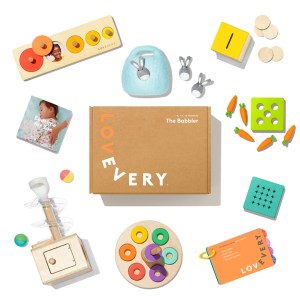6 ideas for dramatic play

Games inspired by acting and the stage are perfect for two-year-olds, who are learning the differences between reality and imagination, how to play pretend, and the joys of making others laugh. Offering them a chance to “act,” with clear and easy rules, lets them perform for others and gives them a fun, low-stakes way of putting on a show.
As children approach the three-year mark, they’re more and more able to engage in what’s called symbolic play: using objects to stand in for others (a banana as a phone, or a toy teacup as a real one). They aren’t yet able to get into truly imaginative play because they can’t conceive of experiences they haven’t lived or seen—but there’s a whole world of pretend play available to them.
Here are 6 ideas for dramatic play with your two-year-old:
Tea party
Tea parties are a classic for a reason: they can be done anywhere and anytime, and invite all kinds of pretend play. Serve steaming hot tea, put your pinkies up, and enjoy high tea with your child and any stuffies they may want to invite.
Mystery Basket
Find a box, basket, or another container with a lid, and place one object at a time inside without letting your child see what it is:
- Cup to drink from
- Spoon or fork
- Baby bottle
- Pretend food
- A toy phone to talk on
- Kitchen items like a small spoon or measuring cup
- Makeup brush or a toothbrush
- A packet of tissues
Demonstrate for your child by pulling out the object and playing pretend with it—“drink” from the bottle, “eat” the pretend food, “talk” on the play phone. Then put another object in without them seeing what it is, and have them pull it out and play pretend.
Sound ball
Sit across from your child with your legs in a V, and find a soft ball. Roll the ball gently to your child and make a silly sound (“whee!” or “pop!” or anything that can be easily copied). Make the sound when you roll, and encourage your child to make the same sound when the ball reaches their hands. Next, it’s their turn: if they struggle to come up with their own sound, you can offer them one; they may also be content to repeat the sounds you’ve already made.
Mailbox

Mail delivery tends to be pretty exciting for little ones; yours may already insist on bringing the mail in from the mailbox, or want to be in charge of letters dropped through the door slot.
Set up a few “mailboxes” around your home for specific people, pets, and stuffed animals; they can be simple boxes or containers. You can put a mailbox by the dog’s bed, by mama’s desk, and by the doll house where their favourite doll lives. Hand your child some “letters” (junk mail, magazines, scratch paper) and ask them to deliver the mail. Kids at this age often love writing their own letters—even though the marks they make aren’t legible yet, encouraging them to “write” empowers them to think of themselves as writers.
Sound meter
2-year-olds are learning how to control the volume of their voice, which is a complicated skill. A great way to practice is with a game called “sound meter:”
- Put your hand out flat in front of you and say “aaaaah” at a normal speaking volume
- Explain that your hand will show how loud or soft your “aahs” should be; when it hits the floor the sound goes off, and when it goes way up high you get loud (but no screaming 😉)
- Practice the highest volume you’ll want to reach, so they have a sense of how loud to get
- Bring your hand up and down, and lead with your own voice
- Encourage your child to join you: “try to match my hand and my voice.”
Nature play
When you’re outside with your child—or even indoors watching a storm from the comfort of a warm room—notice branches waving, the rustling of the leaves, and the drips of rainwater forming on the window and sliding down. Help your child imitate the natural world around them in rhythmic ways, and if you’re able, try to get your own body moving as well:
- Sway like a tree
- Drip like water on a pane of glass (you can act like the window, and they can be the drops—then switch!)
- Chirp the sounds of a bird
- Drum (on any available surface) to the rhythm of the rain
- Gobble up nuts like a squirrel
In this post

The Play Kits
The Play Kits by Lovevery are thoroughly tested, baby safe, eco-friendly and Montessori inspired. Give your child the best start with our stage-based play toy subscription boxes.
Learn morePosted in: 34 - 36 Months, Imagination, Playtime & Activities, Pretend Play, Child Development
Keep reading

22 - 24 Months
25 - 27 Months
28 - 30 Months
31 - 33 Months
34 - 36 Months
Our favourite birthday and holiday gift ideas for 2-year-olds
These fun gift ideas for 2-year-olds support their motor skills, independence, and creativity.

19 - 21 Months
22 - 24 Months
25 - 27 Months
28 - 30 Months
31 - 33 Months
34 - 36 Months
What kind of chores are right for my child?
Children as young as 18 months can start taking on regular household responsibilities. These will be simple and straightforward, like wiping up spills or helping set the table, and will require modeling and patience from you.

34 - 36 Months
How to Montessori your bathroom, by @our.montessori.journey
Some small tweaks to your bathroom can help set up your toddler for success, with toileting, handwashing, bathtime, and more.
